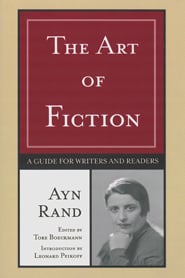

In 1958, by popular demand, Ayn Rand gave an informal course on the art of fiction to a group of friends and acquaintances in her own living room.
As editor Tore Boeckmann notes in his preface, Rand “prepared for each of her lectures on fiction only by making some brief notes on a sheet or two of paper. . . . Given the extemporaneous nature of Ayn Rand’s lectures, the transcript of the tape recordings had to be edited before publication. My editing was aimed at giving the material the economy, smoothness, and precision proper to written prose; it consisted primarily of cutting, reorganizing, and line editing.”
These edited transcripts of her lectures contain a vast range of insights that will appeal to both fiction writers and readers.
In The Art of Fiction, Ayn Rand analyzes how a writer combines abstract ideas with concrete action and description to achieve a unity of theme, plot, characterization and style — the four essential elements of fiction.
Rand also discusses how the seemingly causeless phenomenon of literary “inspiration” is a function of a writer’s conscious thinking; how to develop a voice of one’s own (“You cannot borrow another man’s soul, and you cannot borrow his style”); and why all works of fiction — from great literature to detective stories — express a specific code of values (“Every writer is a moral philosopher”).
Here, too, are Ayn Rand’s illuminating sentence-by-sentence analyses of passages from writers such as Victor Hugo and Thomas Wolfe, illustrative rewrites of scenes from her own works, and fascinating rules for building dramatic plots and characters with depth, including discussion of her new concept of a plot-theme.
“I can give you the reason for every word and every punctuation mark in Atlas Shrugged — and there are 645,000 words in it by the printer’s count. I did not have to calculate it all consciously when I was writing. But what I did was follow a conscious intention in relation to the novel’s theme and to every element involved in that theme. I was conscious of my purpose throughout the job — the general purpose of the novel and the particular purpose of every chapter, paragraph, and sentence.
“To master the art of writing, you have to be conscious of why you are doing things — but do not edit yourself while writing. Just as you cannot change horses in the middle of a stream, so you cannot change premises in the middle of writing. When you write, you have to rely on your subconscious; you cannot doubt yourself and edit every sentence as it comes out. Write as it comes to you — then (next morning, preferably) turn editor and read over what you have written.”
Literature, Rand says, “is an art form which uses language as its tool — and language is an objectiveinstrument.” In The Art of Fiction, Rand looks at how to use language with precision.
If you want to communicate as a writer, then you must use “words with absolute clarity.” The motto of every writer, she says, should be to “regard language as a tool of honor, always to be used as if one were under oath — an oath of allegiance to reality.”
Rand offers advice on how to develop this ability, such as this: “With the exception of proper names, every word is an abstraction. One way to have words come to you easily — words which express the exact shade of meaning you want — is to know clearly the concretes that belong under your abstractions.”
Ayn Rand agrees with the fundamental principle of Romanticism, and in The Art of Fiction she regularly contrasts Romanticism in literature with Naturalism and other approaches.
“The main distinction between a Romantic and a Naturalistic novel,” she argues, “is that a Romantic novel has a plot where as a Naturalistic novel is plotless.”
When it comes to characterization, “The Naturalistic method is to present only one layer of motivation; the Romantic method is to look not only at the immediate onion skin, but as deep as the author can go.”
The basic philosophical distinction between Naturalism and Romanticism, Rand explains, comes down to the author’s view of free will. “The Romantic school of literature approaches life on the premise that man has free will, the capacity of choice.” In contrast, if “a writer’s basic conviction is that man is a determined creature . . . that writer will be a Naturalist. The Naturalistic school, in essence, presents man as helpless.”
Many fiction writing guides stress the importance of showing versus telling. Rand explains the point from a deep philosophical perspective.
“The purpose of all art is the objectification of values. The fundamental motive of a writer . . . is to objectify his values, his view of what is important in life. . . .
“To objectify values is to make them real by presenting them in concrete form. For instance, to say ‘I think courage is good’ is not to objectify a value. To present a man who acts bravely, is.”
Why, Rand asks, is objectifying values — showing rather than telling — important? “Human values are abstractions. Before they can become real to or convince anyone, the concretes have to be given.”
“The most important element of a novel,” according to Rand, “is plot.” A plot is not the same thing as a story. Good Naturalistic novels, Rand says, have a series of events that add up to a story. But a “plot is a purposeful progression of events. Such events must be logically connected, each being the outgrowth of the preceding and all leading up to a final climax.”
In Rand’s view, plot structure is distinctive to the Romantic school of literature, with its conviction that man has free will. “If man has the capacity of choice, then he can plan the events of his life; he can set himself purposes and achieve them. If so, his life is not a series of accidents. Events do not ‘just happen’ to him; he chooses what he makes happen (and if accidents occur, his purpose is to overcome them). He is the architect of his own life.”
The Art of Fiction contains a fascinating discussion of humor. “Humor is a metaphysical negation. We regard as funny that which contradicts reality: the incongruous and the grotesque.”
Rand rejects the popular notion that one must be able to laugh at anything. “What you find funny,” Rand observes, “depends on what you want to negate. It is proper to laugh at evil (the literary form of which is satire) or at the negligible. But to laugh at the good is vicious. If you laugh at any value that suddenly shows feet of clay . . . you are laughing at the validity of values as such.”
The fact that we so often hear that we should laugh at everything, Rand concludes, “is the worst symptom of our nonvalue age. When that line is repeated too often in a society, it is a sign of the collapse of all values.”